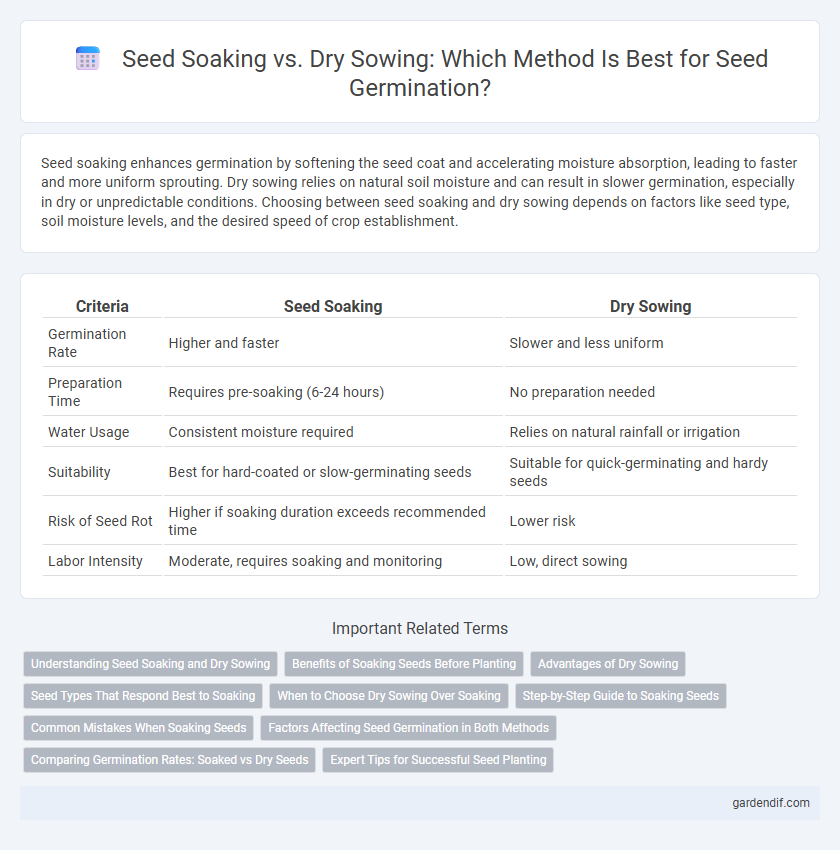
Seed soaking vs Dry sowing Illustration
Seed soaking enhances germination by softening the seed coat and accelerating moisture absorption, leading to faster and more uniform sprouting. Dry sowing relies on natural soil moisture and can result in slower germination, especially in dry or unpredictable conditions. Choosing between seed soaking and dry sowing depends on factors like seed type, soil moisture levels, and the desired speed of crop establishment.
Table of Comparison
| Criteria | Seed Soaking | Dry Sowing |
|---|---|---|
| Germination Rate | Higher and faster | Slower and less uniform |
| Preparation Time | Requires pre-soaking (6-24 hours) | No preparation needed |
| Water Usage | Consistent moisture required | Relies on natural rainfall or irrigation |
| Suitability | Best for hard-coated or slow-germinating seeds | Suitable for quick-germinating and hardy seeds |
| Risk of Seed Rot | Higher if soaking duration exceeds recommended time | Lower risk |
| Labor Intensity | Moderate, requires soaking and monitoring | Low, direct sowing |
Understanding Seed Soaking and Dry Sowing
Seed soaking enhances germination rates by allowing water to penetrate the seed coat, softening it and initiating the growth process more rapidly. Dry sowing involves planting seeds directly into the soil without pre-treatment, relying on natural moisture and temperature conditions to trigger germination. Understanding these methods helps optimize seedling emergence based on species-specific requirements and environmental factors.
Benefits of Soaking Seeds Before Planting
Soaking seeds before planting accelerates germination by softening seed coats and improving water absorption, leading to faster sprout emergence. This method enhances seedling vigor and increases overall germination rates compared to dry sowing, particularly for hard-coated seeds like beans and peas. Soaked seeds also reduce the risk of soil-borne diseases by shortening the vulnerable germination period, promoting healthier plant growth.
Advantages of Dry Sowing
Dry sowing enhances seed germination by allowing farmers to plant seeds directly into dry soil, reducing labor and water usage compared to seed soaking methods. This technique promotes better seedling establishment by preventing seed rot and fungal infections commonly associated with excess moisture. Furthermore, dry sowing facilitates earlier planting times and improved seed storage, ensuring higher crop yields and efficient field management.
Seed Types That Respond Best to Soaking
Seeds with hard coats such as beans, peas, and morning glories respond best to soaking because it softens their outer layer, accelerating germination. Large seeds like sunflower and pumpkin also benefit from soaking as it helps to increase moisture absorption and promotes faster sprouting. In contrast, tiny or very delicate seeds generally perform better with dry sowing to avoid damage and mold growth.
When to Choose Dry Sowing Over Soaking
Dry sowing is preferable when dealing with hard-coated seeds that require natural weathering processes to break dormancy, such as lupines or sweet peas. It is also ideal in climates with consistent moisture and moderate temperatures, where soaking could lead to seed rot or fungal issues. Dry sowing mimics natural seed dispersal timing, promoting better root development and seedling vigor in species adapted to these conditions.
Step-by-Step Guide to Soaking Seeds
Soaking seeds before planting involves immersing them in water for 8 to 12 hours to soften the seed coat and accelerate germination. After soaking, seeds should be drained and either planted immediately or placed in a damp paper towel for sprouting. This method boosts seed moisture absorption, improves germination rates, and reduces the time required for seedlings to emerge compared to dry sowing.
Common Mistakes When Soaking Seeds
Soaking seeds can accelerate germination but common mistakes include soaking for too long, which can lead to seed rot or mold growth, and soaking in non-sterile water, increasing the risk of fungal infection. Using excessively warm water may damage seed viability, while some seeds require pre-treatment or scarification before soaking for optimal results. Ensuring seeds are thoroughly dried after soaking prevents clumping and bacterial growth during sowing.
Factors Affecting Seed Germination in Both Methods
Seed soaking enhances water absorption, leading to faster and more uniform germination by softening the seed coat and activating metabolic processes. Dry sowing relies on natural soil moisture and temperature, often resulting in slower germination due to variable environmental conditions. Factors such as seed coat permeability, soil moisture levels, temperature fluctuations, and oxygen availability significantly influence germination success in both seed soaking and dry sowing methods.
Comparing Germination Rates: Soaked vs Dry Seeds
Soaked seeds often exhibit faster and higher germination rates compared to dry seeds due to improved water absorption that activates enzymatic processes necessary for sprouting. Dry sowing can lead to slower germination and increased risk of seed desiccation, especially in arid or unpredictable conditions. Studies indicate soaking seeds for 12 to 24 hours enhances overall germination efficiency by accelerating metabolic activity and reducing dormancy periods.
Expert Tips for Successful Seed Planting
Soaking seeds before planting accelerates germination by softening the seed coat and improving moisture absorption, especially for hard-coated varieties like beans and peas. Dry sowing is ideal for seeds that require stratification or are sensitive to excess moisture, such as carrots and lettuce, ensuring proper root development without rot risk. Using expert tips like adjusting soaking time based on seed size and always planting soaked seeds promptly enhances germination rates and seedling vigor.
Seed soaking vs Dry sowing Infographic

 gardendif.com
gardendif.com